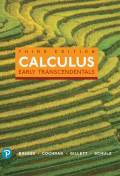
Concept explainers
No
a. Evaluate
b. Evaluate the line integral using Stokes’ Theorem to check part (a).
Want to see the full answer?
Check out a sample textbook solution
Chapter 17 Solutions
Calculus: Early Transcendentals (3rd Edition)
Additional Math Textbook Solutions
Algebra and Trigonometry (6th Edition)
Elementary Statistics: Picturing the World (7th Edition)
College Algebra (7th Edition)
College Algebra with Modeling & Visualization (5th Edition)
- 3. Mary needs to choose between two investments: One pays 5% compounded annually, and the other pays 4.9% compounded monthly. If she plans to invest $22,000 for 3 years, which investment should she choose? How much extra interest will she earn by making the better choice? For all word problems, your solution must be presented in a sentence in the context of the problem.arrow_forward4 πT14 Sin (X) 3 Sin(2x) e dx 1716 S (sinx + cosx) dxarrow_forwardLet g(x) = f(t) dt, where f is the function whose graph is shown. 3 y f(t) MA t (a) At what values of x do the local maximum and minimum values of g occur? Xmin = Xmin = Xmax = Xmax = (smaller x-value) (larger x-value) (smaller x-value) (larger x-value) (b) Where does g attain its absolute maximum value? x = (c) On what interval is g concave downward? (Enter your answer using interval notation.)arrow_forward
- 2. Graph the function f(x)=e* −1. Label three points on the graph (one should be the intercept) with corresponding ordered pairs (round to one decimal place) and label the asymptote with its equation. Write the domain and range of the function in interval notation. Make your graph big enough to see all important features. You may show the final graph only.arrow_forwardansewer both questions in a very detailed manner . thanks!arrow_forwardQuestion Considering the definition of f(x) below, find lim f(x). Select the correct answer below: -56 -44 ○ -35 ○ The limit does not exist. x+6 -2x² + 3x 2 if x-4 f(x) = -x2 -x-2 if -4x6 -x²+1 if x > 6arrow_forward
- Let g(x) = f(t) dt, where f is the function whose graph is shown. y 5 f 20 30 t (a) Evaluate g(x) for x = 0, 5, 10, 15, 20, 25, and 30. g(0) = g(5) = g(10) = g(15) =| g(20) = g(25) = g(30) = (b) Estimate g(35). (Use the midpoint to get the most precise estimate.) g(35) = (c) Where does g have a maximum and a minimum value? minimum x= maximum x=arrow_forwardQuestion Determine lim f(x) given the definition of f(x) below. (If the limit does not exist, enter DNE.) x+6+ -2x²+3x-2 f(x) -2x-1 if x-5 if -−5≤ x ≤ 6 3 if x 6arrow_forwardQuestion Given the following piecewise function, evaluate lim f(x). (If the limit does not exist, enter DNE.) x-3 Provide your answer below: x² + 3x 3 if x-3 f(x) -3 if -3x -2x²+2x-1 6 if x 6arrow_forward
- Question Given the following piecewise function, evaluate lim f(x). x→2 Select the correct answer below: -73 -24 -9 -12 The limit does not exist. 2x f(x) = -2x²-1 if -2x2 3x+2 if x 2arrow_forwardQuestion Given the following piecewise function, evaluate lim f(x). f(x) = x+1- -2x² - 2x 3x-2 2 x² +3 if x-2 if -2< x <1 if x 1 Select the correct answer below: ○ -4 ○ 1 ○ 4 The limit does not exist.arrow_forwardQuestion Given the following piecewise function, evaluate lim →1− f(x). Select the correct answer below: ○ 1 ○ 4 -4 The limit does not exist. -2x² - 2x x 1arrow_forward
 Calculus: Early TranscendentalsCalculusISBN:9781285741550Author:James StewartPublisher:Cengage Learning
Calculus: Early TranscendentalsCalculusISBN:9781285741550Author:James StewartPublisher:Cengage Learning Thomas' Calculus (14th Edition)CalculusISBN:9780134438986Author:Joel R. Hass, Christopher E. Heil, Maurice D. WeirPublisher:PEARSON
Thomas' Calculus (14th Edition)CalculusISBN:9780134438986Author:Joel R. Hass, Christopher E. Heil, Maurice D. WeirPublisher:PEARSON Calculus: Early Transcendentals (3rd Edition)CalculusISBN:9780134763644Author:William L. Briggs, Lyle Cochran, Bernard Gillett, Eric SchulzPublisher:PEARSON
Calculus: Early Transcendentals (3rd Edition)CalculusISBN:9780134763644Author:William L. Briggs, Lyle Cochran, Bernard Gillett, Eric SchulzPublisher:PEARSON Calculus: Early TranscendentalsCalculusISBN:9781319050740Author:Jon Rogawski, Colin Adams, Robert FranzosaPublisher:W. H. Freeman
Calculus: Early TranscendentalsCalculusISBN:9781319050740Author:Jon Rogawski, Colin Adams, Robert FranzosaPublisher:W. H. Freeman
 Calculus: Early Transcendental FunctionsCalculusISBN:9781337552516Author:Ron Larson, Bruce H. EdwardsPublisher:Cengage Learning
Calculus: Early Transcendental FunctionsCalculusISBN:9781337552516Author:Ron Larson, Bruce H. EdwardsPublisher:Cengage Learning





